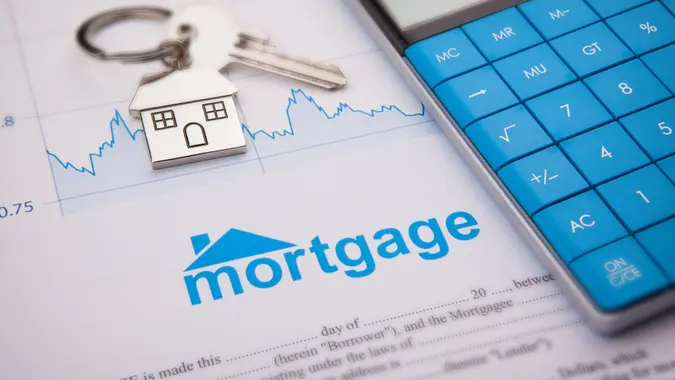Millennials Lost 18% in Home Equity This Year — Here’s Why Borrowing Against Your House Can Be Dangerous

Commitment to Our Readers
GOBankingRates' editorial team is committed to bringing you unbiased reviews and information. We use data-driven methodologies to evaluate financial products and services - our reviews and ratings are not influenced by advertisers. You can read more about our editorial guidelines and our products and services review methodology.

20 Years
Helping You Live Richer

Reviewed
by Experts

Trusted by
Millions of Readers
According to data from Redfin, the total worth of homes in the U.S. set a record of $46.8 trillion in June, besting the previous high of $46.6 trillion set a year earlier as low inventory boosted house values.
Millennials gained more total value of their homes year-over-year in June (2.9%) than any other generation and now own $5 trillion in real estate, per the Redfin estimate. In doing so, they passed the silent generation (those born 1925 to 1945) in property wealth ($4.7 trillion), but still trail far behind Generation X’s and baby boomers’ totals of $13.4 trillion and $18 trillion, respectively.
As members of the silent generation age and subsequently move into retirement residences or pass away, they lose home value. On the other hand, millennials buy more homes every year. As Redfin noted, millennials make up the largest portion of home buyers at this juncture, and have purchased around 60% of houses purchased with mortgages “over the last several years.”
However, while the Gen Y demographic gained total home value, it lost 18% in home equity this year. This figure can be compared to home equity numbers attached to the silent generation (-11.4%), Generation X (-0.7%) and baby boomers (0%), according to the data.
One explanation for this decrease is the higher likelihood of millennials drawing on their home equity, per Redfin Economics research lead Chen Zhao. Zhao noted that many millennials have taken the potentially risky approach of borrowing against the equity their homes gained during the pandemic to pay off pricey home renovations, as well as credit card and student loan debt.
Borrowing against your house, often referred to as a home equity loan or a home equity line of credit (HELOC), is popular because it provides the flexibility of accessing funds throughout the financing period. “That makes them a good option for homeowners who will have varying financial needs over time or those who don’t want a lump sum loan,” per CBS’s MoneyWatch.
However, drawing equity from your home can be risky if not approached with caution and proper planning. While these options can provide access to funds for various purposes like the ones mentioned above, there are potential dangers to consider.
The Dangers of Borrowing Against Your Home
According to Black Knight’s August 2023 Mortgage Report, the average mortgage holder has some $199,000 in available equity. Tapping too much of it can cause a downward turn in finances, which can take a significant emotional toll on you and your family.
Home equity loans can usually be taken out shortly after purchasing a home (often within the first year of ownership), but lenders have specific requirements for approval. Here are the dangers of taking out a home equity loan or line of credit.
Risk of Foreclosure
When you borrow against your house, you are essentially using your home as collateral. If you are unable to make the required payments on the loan or line of credit, you risk the lender taking ownership of your home.
Increased Debt
Borrowing against your house for short-term expenses like vacations or luxury purchases can lead to long-term financial difficulties and add to your debt load. If you’re not careful, you might find yourself owing more than the value of your home, making it difficult to sell or refinance if needed. It’s important to use these funds wisely and consider whether the expense is worth jeopardizing your home.
Interest Costs
Home equity loans and HELOCs come with interest rates. If the interest rates are high or increase over time, you might end up paying significantly more than you initially borrowed. Additionally, many HELOCs have variable interest rates that can fluctuate with market conditions. This can lead to unpredictable changes in your monthly payments, making it difficult to budget.
Lack of Equity and Flexibility
By borrowing against your home, you might deplete your equity, which is the difference between the value of your home and the remaining mortgage balance. This could impact your ability to access financing in the future or hinder your plans for upgrading or relocating. If you encounter unexpected financial challenges, you might not have the flexibility to sell your home and downsize or move to a more affordable location, since your equity could be tied up in the borrowed amount.
Fees and Costs
Borrowing against your house often involves closing costs, appraisal fees, and other expenses. These costs can add up and diminish the benefits of the loan. According to Money, your HELOC might also include a prepayment penalty if you pay off the line of credit before the term ends.
To mitigate the risks associated with home equity loans and HELOCs, it’s important to carefully evaluate your financial situation and motivations for borrowing against your home. As always, it’s wise to consult with an advisor who can help you understand the implications and guide you toward the best course of action for your individual circumstances
If you decide to proceed, you should compare different lenders to find the best terms and interest rates, ensure you can comfortably afford the additional payments, only borrow for necessary expenses that can potentially add value over time (such as home improvements or education) and thoroughly understand the terms of the loan. You should also monitor interest rate changes and build a clear repayment plan.
More From GOBankingRates
 Written by
Written by  Edited by
Edited by 

























